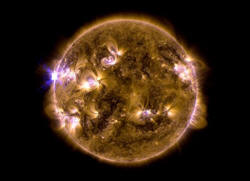 |
|


Sun unleashes strongest solar flare of 2013 so far
[May 14, 2013]
LOS ANGELES (AP)
--
|
The powerful flare occurred Sunday and erupted on the side of the sun that was not facing Earth. While the planet was not hit with radiation, space weather forecasters say the solar blast briefly disrupted high-frequency radio signals. Solar outbursts that are directed at Earth can affect communications systems and power grids and also produce colorful auroras. NASA says radiation from the latest flare may stream toward two of its spacecraft, including the Spitzer Space Telescope. Engineers have the option to put them in safe mode to protect instruments from getting fried. The side of the sun where Sunday's eruption occurred will rotate into Earth's view soon, allowing scientists to study the active region. |


